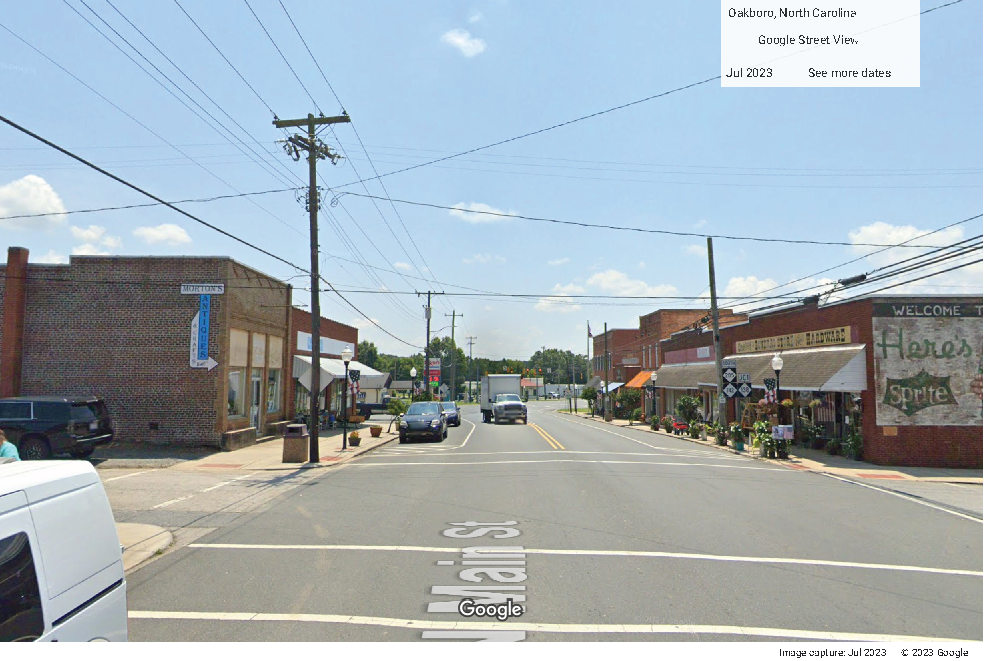Two Lefts Don't Make a Right
There is a problem in Oakboro, North Carolina, that the Oakboro Police Department is being asked to fix. However, this is not a robbery, domestic dispute, or serious injury—something we would expect our first responders to address. No, rather, the Oakboro Police Department has gone viral with a Facebook post responding to citizen complaints at the intersection of North Main Street and East First Street, where drivers are improperly using a left-turn lane. This is not a policing issue, and no level of enforcement can correct it. This is a traffic issue given to the community by a transportation engineer.
Oakboro comprises a regular street grid that is interrupted by a railroad. The result is an intersection that is half a block long where East First Street, Aquadale Road, and Railroad Street coverage on Main Street. The technical term to describe this condition is an offset intersection, because there are two or more streets that do not align.
Main Street in Oakboro is what one would expect to see in a small community with a population under 3,000 people. Main Street is a two-lane road. Outside of town, Main Street is two lanes with a shoulder. In the core of the downtown, the shoulder becomes parallel on-street parking. Outside of the city boundaries for at least two miles, there are no dedicated turn lanes. There are also no traffic lights in the city or on Main Street until you hit the divided highway (Highway 27).
This intersection is a departure from the character of the community—the traffic engineer has introduced a whole new vocabulary of roadway design features. There are dedicated left-turn lanes and right-slip lanes, removing on-street parking. There is not one, but two sets of traffic lights. Finally, there is a lot of asphalt—a lot of asphalt—that has been added to this intersection. This intersection is a hybrid of street and road design where both design objectives—access to local destinations, and efficient movement of traffic—are executed poorly. Or, in other words, this is a stroad.
The North Carolina Department of Transportation has made a significant investment in Oakboro at this intersection. The project was likely intended to ease congestion and improve the flow of cars. I was not privy to all of the design objectives that drove this project, but I do know the resulting design failures are ones we see repeated across North America. The design features included in this intersection attempt to address one set of problems, but they unleash another set of unintended consequences.
This is an issue that needs immediate attention, but the standard State Highway approach may take years to respond, if they respond at all. We cannot expect the Oakboro Police Department to eliminate this problem through traffic enforcement, so what do we do?
Cities across North America have begun responding to these transportation issues in innovative ways. Cincinnati has formed a pedestrian safety team, which is a five-member unit embedded within the city’s Department of Transportation and Engineering (DOTE). Using simple materials such as rubber speed mats, plastic barriers, and high-visibility paint, the team will execute rapid-response, tactical interventions on troubled roadways and intersections. Similarly, the city of Memphis is working with local citizens to support multiple small-scale interventions to reimagine city streets.
These communities understand that the highest level of coordination rests at the level of city government. Local governments can navigate around the bureaucracy found at the state level. Local governments have a much better understanding of the specific problems their residents face, and can take small, immediate steps to focus on the most urgent needs of the community.
In this particular case, Oakboro can test a response with temporary materials they have on hand like cones or wooden barricades. If an idea is a failure, it is a small failure that we learn from. If the response improves the situation, then take the next step to make it permanent. This approach allows for rapid responses to the immediate safety concerns at this intersection managed at the most local level.
Let me share two small steps that could be easily implemented with current resources that Oakboro might want to explore to address this issue. Either of these responses could be implemented with the same materials and with the same ease as the town would use to close the streets for the 4th of July parade.
1. Remove the dedicated left-turn lane on North Main Street onto First.
The left-turn lane could be removed with temporary barricades or cones. This would result in an intersection condition similar to all of the other downtown blocks. This would remove the ability for drivers to pull through the turn lanes.
2. Remove the dedicated left-turn lane on North Main Street onto Aquadale.
The left-turn lane could be removed with temporary barricades or cones. This would result in an island in the middle of the intersection adding a visual narrowing of the street, thus reducing the large field of asphalt at this intersection.
Local governments like Oakboro’s have the authority—and should be encouraged—to undertake trial steps like this to respond to the urgent needs of their communities, and to observe and iterate on the results. The only failure in this process would be the failure to act, at all.












On this episode of the Strong Towns Podcast, Chuck discusses safe streets advocacy with Amy Cohen, the co-founder and president of Families for Safe Streets.